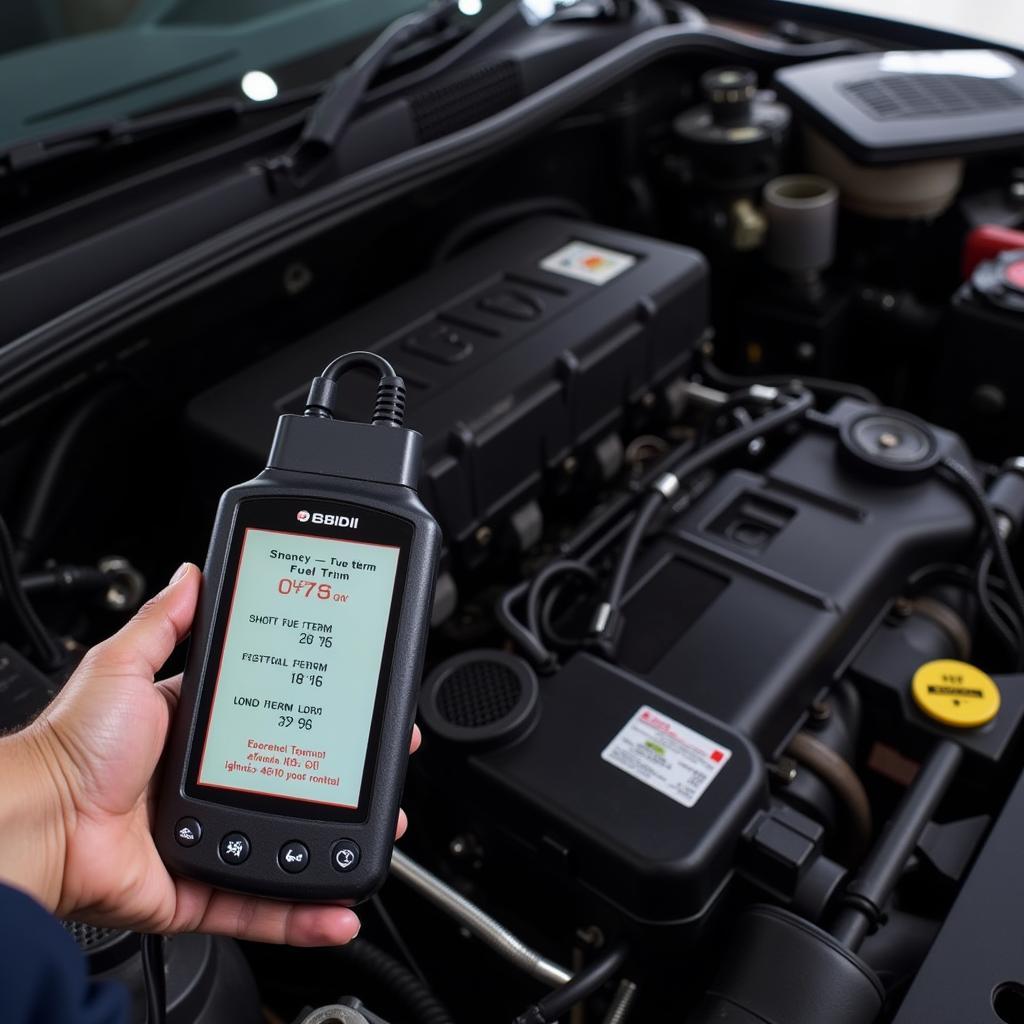Understanding your vehicle’s fuel mixture is crucial for optimal performance and fuel efficiency. Knowing How To Read Fuel Mixture On A Scan Tool empowers you to diagnose potential issues and ensure your engine is running smoothly. This guide will walk you through the process, explaining the key parameters and what they signify.
A vehicle’s air-fuel ratio is the proportion of air to fuel entering the engine’s cylinders. The ideal ratio, known as stoichiometric, is typically 14.7:1 for gasoline engines. This means 14.7 parts of air are mixed with one part of fuel. Deviations from this ideal ratio can indicate problems with various engine components, impacting performance and emissions. Using a scan tool, you can access real-time data about your fuel mixture, helping you pinpoint the root cause of these issues. Similar to ford obd2 scan tool, understanding the data provided can be instrumental in effective diagnostics.
Understanding Fuel Trim
Fuel trim is a key parameter displayed by your scan tool that indicates how the engine’s computer (ECU) is adjusting the fuel mixture. There are two types of fuel trim: short-term and long-term.
Short-Term Fuel Trim (STFT)
STFT reflects immediate adjustments the ECU makes to the fuel mixture based on real-time sensor readings. It indicates how the engine is adapting to changing conditions, such as acceleration, deceleration, and varying engine loads.
Long-Term Fuel Trim (LTFT)
LTFT represents the average adjustments the ECU has made over a longer period. It provides a broader picture of the fuel mixture and can highlight persistent issues that STFT might not capture.
How to Access Fuel Trim Data on a Scan Tool
Accessing fuel trim data is generally straightforward. Connect your scan tool to the vehicle’s OBD-II port, typically located under the dashboard on the driver’s side. Turn the ignition on, but don’t start the engine. Select the “Data Stream” or “Live Data” option on your scan tool. Locate the parameters for STFT and LTFT, which are usually expressed as percentages.
 Reading Fuel Trim on a Scan Tool
Reading Fuel Trim on a Scan Tool
Interpreting Fuel Trim Readings
Interpreting fuel trim readings requires understanding the percentage values displayed. A positive value indicates the ECU is adding fuel to the mixture, meaning the engine is running lean. A negative value indicates the ECU is reducing fuel, meaning the engine is running rich. Generally, fuel trim values within ±10% are considered acceptable. Larger deviations suggest a problem that needs further investigation. This is similar to how you would interpret scanner codes for cars, identifying the underlying issue.
Common Causes of Fuel Trim Issues
Several factors can contribute to fuel trim problems. These include vacuum leaks, faulty oxygen sensors, malfunctioning mass airflow sensors (MAF), fuel pressure issues, and even clogged fuel injectors. Identifying the specific cause often requires additional diagnostic steps, such as checking for vacuum leaks with a smoke machine or testing the oxygen sensor voltage.
What if I have No Fuel Trim Reading?
Sometimes, your scan tool might not display any fuel trim readings. This can be caused by several issues, including a faulty scan tool, a communication problem between the scan tool and the ECU, or a problem with the ECU itself. You might encounter no fuel trim reading on scan tool due to various reasons.
Tips for Accurate Fuel Trim Readings
- Ensure your scan tool is compatible with your vehicle’s make and model.
- Use a high-quality scan tool for accurate and reliable readings.
- Warm up the engine to operating temperature before taking readings.
- Perform the test under various driving conditions to get a complete picture of the fuel mixture. Looking for a reliable scan tool? Consider the super ford scanner usb scan tool for comprehensive diagnostics.
Expert Insights
John Smith, a seasoned automotive diagnostician with over 20 years of experience, advises, “Understanding fuel trim is fundamental for any technician. It’s a powerful tool for diagnosing a wide range of engine performance issues.” He also adds, “Always consider the context of other data parameters and diagnostic trouble codes (DTCs) when interpreting fuel trim readings for a comprehensive diagnosis.”
Another expert, Maria Garcia, a certified master technician, emphasizes the importance of regular maintenance. “Consistent maintenance, such as replacing air filters and spark plugs, can help prevent fuel trim issues and ensure optimal engine performance,” she says. As experts like scan tool man often point out, consistent maintenance is key to vehicle longevity.
Conclusion
Learning how to read fuel mixture on a scan tool is an essential skill for any car owner or technician. By understanding fuel trim and other related parameters, you can effectively diagnose and address potential engine problems, improving performance, fuel efficiency, and reducing emissions. For further assistance or if you encounter persistent issues, feel free to connect with ScanToolUS at +1 (641) 206-8880. Our office is located at 1615 S Laramie Ave, Cicero, IL 60804, USA.

